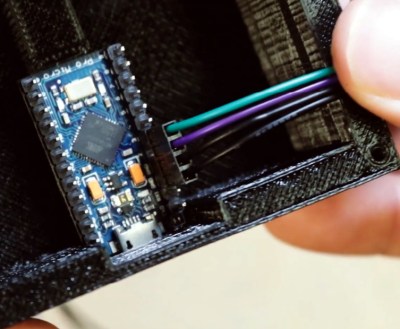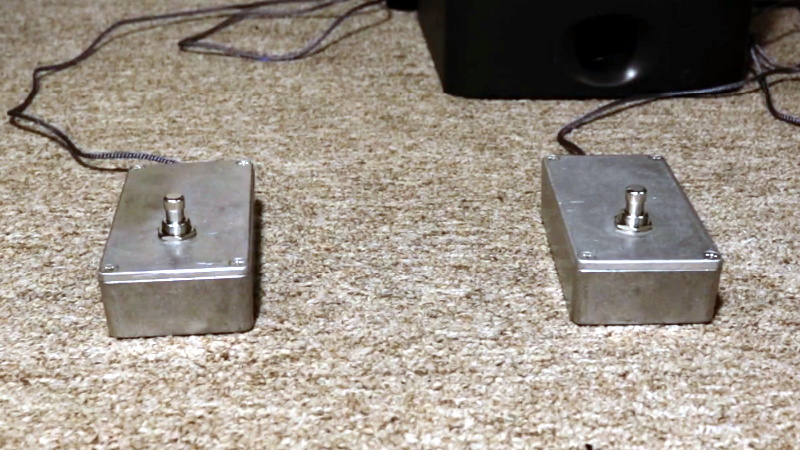You’ve (probably) got four limbs, so why are you only using half of them when you’re working on the computer? Just because your toes don’t have the dexterity to type (again, probably) doesn’t mean your feet should get to just sit there doing nothing all day. In a recent project, [MacCraiger] shows you just how easy it can be to put some functionality under foot by building a pair of media control stomp switches.

If the devices pictured above look a lot like guitar effects, that’s because they share a lot of parts. [MacCraiger] used the same sort of switch and aluminum case that you might see on a pedal board, as he figured they’d be better suited to a lifetime of being stepped on than something he 3D printed.
Up on the desk, and this time in a printed case, is the Arduino Leonardo that they connect to. The wiring for this project is very straightforward, with the switches connected directly to the GPIO pins. From there, the Arduino firmware emulates a USB Human Interface Device and fires off the appropriate media control keystrokes to skip to the next track or pause playback depending on which switch has been engaged.
This hardware isn’t exactly breaking any new ground here, but we did like how [MacCraiger] used standard 3.5 mm audio cable and the associated jacks to connect everything up. It’s obviously on-theme for what’s essentially a music project, but more importantly, gives the whole thing a very professional look. Definitely a tip to mentally file away for the future.
For the more accomplished toe-tapper, our very own [Kristina Panos] recently recently took us through the construction of her macro slinging footstool. Between these two examples of bespoke peripherals, you should have everything you need to create your own custom input devices. We suppose you could even make one that’s hand operated if you’re into that sort of thing.
















Well done, I like the use of off the shelf parts. Looks clean, and should survive being kicked around and stomped on.
Those little buttons are murder on sock feet. I use a cheap-but nice pedal-type switch, plentiful on Amazon et al. for less than $15.
Or you can get the full-on transcriber 3-pedal rigs, built espressly for this purpose, for $50-$100. They’re about the BOM cost of this build, but minus the fun, a day of your time, and of course minus the youtube clicks.
There are aluminum button caps that you can buy that mount to the top of the foot switch and increase the surface area that you press on. I think they’re meant for using guitar pedals with your hands, but I think they would work well for socked ore bare feet.
I’ve been thinking of something kind of like this, though using microphones to turn a regular flat surface into a large touchpad with certain areas designated as buttons (HID ON/OFF, scroll UP/DOWN, Volume +/-, etc, etc) via strips of plastic molded into shapes that can be recognized by feel.
A system like this could be very useful for those times when I’m trying to read while my cat is yet again demanding attention.
Charity shops often sell the tough metal pedals used in old time dicta phone setups. Cheap, solid both mechanically, and electrically.
This will be useful as a Stop/Esc command in Eagle :)
Nice!
I did almost exactly the same thing:
Took an old Marshall pedal board with 2 momentary switches and an Arduino Leonardo, connect it via USB to my tablet and make it turn the pdf pages of music sheets (arrow button left/right) while having the hands free to play the trumpet.
On the stage it just looks professional :-)
so i can skip songs like this
https://www.youtube.com/watch?v=vSdbQLXpmPQ
inspired by his choice of arduino
I think the box was designed to be the other way round, screws on bottom. And those are switches, not buttons so you have to do some flip flopping in the code… and don’t use spring loaded punches like that on cast metals, they can shatter. Just fyi.
My least favorite arduino there as well – NO mounting holes! What were they thinking?
Macro keys are always nice to have though. I made some up with a digispark for a coworker who has to always type some long string of numbers throughout the day (FedEx codes) and that was a big time saver for him.
Interesting to know. I had to drill a very similar cast metal box a few days ago and I wished to have such a spring loaded punch because I thought it would be easier on the metal. I feared to bend the sidewalls inwards, as it is difficult to support the metal there. As I don’t have one, I used a normal one very carefully with low force.
As a musician with a fair amount of stomp box effects, this would make me feel right at home. I could add much more in the line of boxes as, being on a dark stage, setting up the boxes in a comfortable position allows me to hit them without looking. Could apply the same principle under the desk.